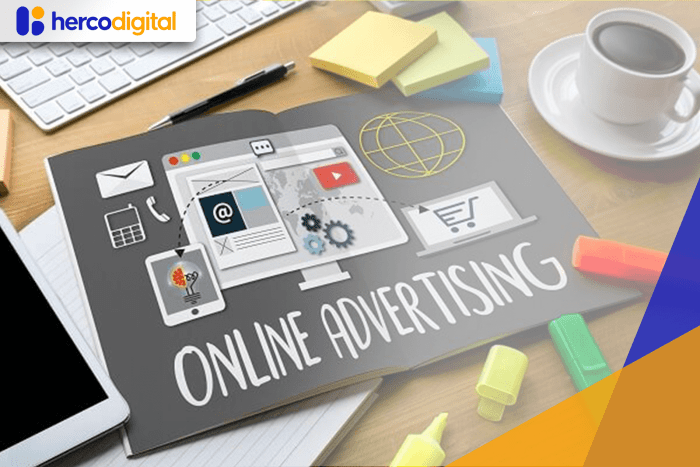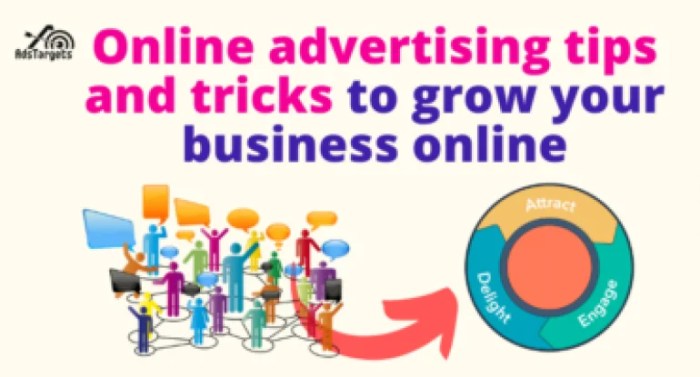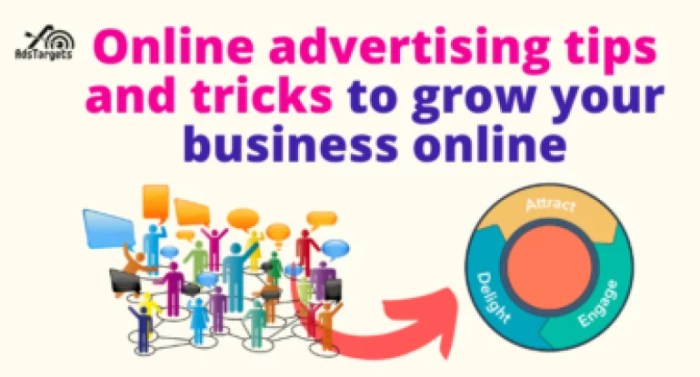Starting off with Online Advertising Tips, get ready to dive into the world of digital marketing where success is just a click away.
From the importance of online advertising to tips for creating effective ads, this guide has got you covered.
Importance of Online Advertising
In today’s digital age, online advertising plays a crucial role in the success of businesses. With the majority of consumers spending a significant amount of time online, reaching them through digital platforms has become essential for any company looking to grow and expand their reach.
Benefits of Online Advertising
- Increased Reach: Online advertising allows businesses to target a global audience, reaching potential customers beyond geographical boundaries.
- Cost-Effective: Compared to traditional advertising methods like TV or print, online advertising is more budget-friendly and offers better ROI.
- Targeted Marketing: With tools like social media ads and Google AdWords, businesses can target specific demographics, interests, and behaviors of their audience.
- Measurable Results: Online advertising provides detailed analytics and insights, allowing businesses to track the performance of their campaigns in real-time.
Successful Online Advertising Campaigns
- Apple’s “Shot on iPhone” Campaign: By showcasing user-generated content captured on iPhones, Apple created an engaging and relatable campaign that helped boost sales and brand loyalty.
- Dollar Shave Club’s Viral Video: The humorous and unconventional video went viral, leading to a significant increase in subscriptions and brand awareness for the company.
- Amazon’s Personalized Recommendations: By utilizing data-driven personalized recommendations, Amazon has been able to increase sales by providing a tailored shopping experience for each user.
Types of Online Advertising

Online advertising comes in various forms, each with its unique advantages and disadvantages. Let’s explore the different types of online advertising and how companies effectively utilize them to reach their target audience.
Display Ads
Display ads are visual advertisements that appear on websites, apps, or social media platforms. They can include banners, videos, or interactive ads.
- Pros:
- Eye-catching and visually appealing
- Can be easily targeted based on demographics and interests
- Cons:
- Ad blockers can impact visibility
- May be perceived as intrusive by users
One example of a company effectively using display ads is Nike, which showcases their latest products through engaging banner ads on popular websites.
Social Media Ads
Social media ads are paid advertisements that appear on social networking platforms like Facebook, Instagram, Twitter, and LinkedIn.
- Pros:
- Highly targeted based on user demographics and behavior
- Opportunity for engagement and interaction with users
- Cons:
- Users may scroll past ads without engaging
- Competition for visibility among other ads
An example of effective social media advertising is Coca-Cola, which creates engaging video ads on Facebook and Instagram to promote their brand.
Search Engine Marketing, Online Advertising Tips
Search engine marketing involves placing ads on search engine results pages, such as Google Ads.
- Pros:
- Targets users actively searching for specific s
- Provides measurable results through click-through rates and conversions
- Cons:
- Costly, especially for competitive s
- Requires continuous optimization to maintain effectiveness
A company effectively using search engine marketing is Amazon, which bids on relevant s to appear at the top of search results on Google.
Influencer Marketing
Influencer marketing involves collaborating with social media influencers to promote products or services to their followers.
- Pros:
- Authentic endorsement from influencers can build trust with their audience
- Reaches a specific niche audience through influencers’ followers
- Cons:
- Costly, depending on the influencer’s reach and engagement
- Risk of negative association if the influencer’s reputation is tarnished
An example of successful influencer marketing is Gymshark, which partners with fitness influencers on Instagram to promote their activewear products to a health-conscious audience.
Tips for Creating Effective Online Ads
Creating effective online ads is crucial for the success of any digital marketing campaign. Compelling visuals and persuasive ad copy play a significant role in catching the attention of your target audience and encouraging them to take action. Here are some tips to help you create online ads that drive results:
Importance of Compelling Visuals and Ad Copy
When it comes to online advertising, visuals and ad copy are the first things that your audience will see. It is essential to make a strong first impression to capture their interest and encourage them to engage with your ad. Compelling visuals can include eye-catching images, videos, or graphics that are relevant to your message. Meanwhile, persuasive ad copy should be concise, clear, and compelling, highlighting the benefits of your product or service.
Strategies for Targeting the Right Audience
Targeting the right audience is key to the success of your online ads. Utilize audience segmentation tools provided by advertising platforms to target specific demographics, interests, behaviors, and locations. Conduct thorough research to understand your target audience’s preferences, pain points, and buying behaviors. By tailoring your ads to the needs and interests of your target audience, you can increase the effectiveness of your campaigns.
Best Practices for Optimizing Online Ads for Different Platforms
Different online advertising platforms have varying requirements and best practices for ad optimization. Ensure that your ads are optimized for each platform by following guidelines for image sizes, ad formats, and character limits. A/B testing different ad variations can help you identify which elements resonate best with your audience. Additionally, monitor the performance of your ads regularly and make adjustments based on the data to improve their effectiveness over time.
Budgeting and ROI in Online Advertising: Online Advertising Tips

In the world of online advertising, setting a budget and measuring return on investment (ROI) are crucial for the success of any campaign. Let’s dive into how you can effectively manage your budget and maximize ROI in online advertising.
Setting a Budget
When setting a budget for online advertising campaigns, it’s important to consider your overall marketing goals, target audience, and the platforms you plan to utilize. Here are some steps to help you set a budget:
- Define your campaign objectives and KPIs (Key Performance Indicators).
- Research the average CPC (Cost Per Click) or CPM (Cost Per Thousand Impressions) for your industry.
- Allocate your budget based on the platforms that will reach your target audience effectively.
- Monitor and adjust your budget as needed based on campaign performance.
Measuring ROI for Online Ads
Measuring ROI for online ads involves tracking and analyzing key metrics to determine the effectiveness of your campaigns. Here are some ways to measure ROI:
- Track conversions and sales generated from your online ads.
- Calculate your ROI using the formula:
(Revenue – Cost of Ads) / Cost of Ads x 100%
- Utilize tools like Google Analytics to track campaign performance and ROI.
- Compare ROI across different campaigns to identify top-performing strategies.
Tips for Maximizing ROI
To maximize ROI and minimize costs in online advertising, consider the following tips:
- Optimize your ad copy and creative to improve click-through rates.
- Target specific audiences to increase relevance and conversions.
- A/B test your ads to identify the most effective messaging and visuals.
- Monitor your campaigns regularly and make adjustments based on performance data.






